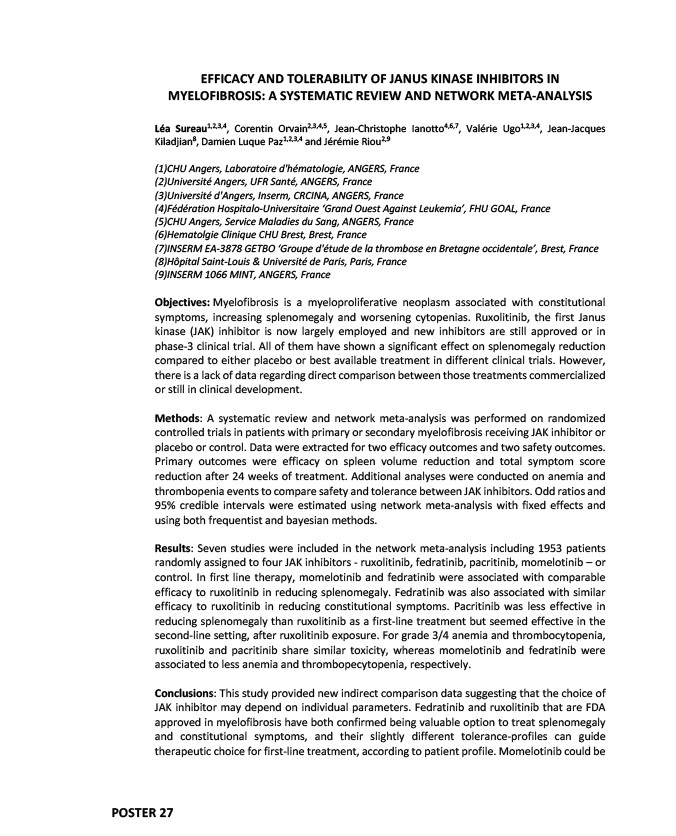
POSTER 27
EFFICACY AND TOLERABILITY OF JANUS KINASE INHIBITORS IN
MYELOFIBROSIS: A SYSTEMATIC REVIEW AND NETWORK META-ANALYSIS
Léa Sureau1,2,3,4, Corentin Orvain2,3,4,5, Jean-Christophe Ianotto4,6,7, Valérie Ugo1,2,3,4, Jean-Jacques
Kiladjian8, Damien Luque Paz1,2,3,4 and Jérémie Riou2,9
(1)CHU Angers, Laboratoire d'hématologie, ANGERS, France
(2)Université Angers, UFR Santé, ANGERS, France
(3)Université d'Angers, Inserm, CRCINA, ANGERS, France
(4)Fédération Hospitalo-Universitaire ‘Grand Ouest Against Leukemia’, FHU GOAL, France
(5)CHU Angers, Service Maladies du Sang, ANGERS, France
(6)Hematolgie Clinique CHU Brest, Brest, France
(7)INSERM EA-3878 GETBO ‘Groupe d'étude de la thrombose en Bretagne occidentale’, Brest, France
(8)Hôpital Saint-Louis & Université de Paris, Paris, France
(9)INSERM 1066 MINT, ANGERS, France
Objectives: Myelofibrosis is a myeloproliferative neoplasm associated with constitutional
symptoms, increasing splenomegaly and worsening cytopenias. Ruxolitinib, the first Janus
kinase (JAK) inhibitor is now largely employed and new inhibitors are still approved or in
phase-3 clinical trial. All of them have shown a significant effect on splenomegaly reduction
compared to either placebo or best available treatment in different clinical trials. However,
there is a lack of data regarding direct comparison between those treatments commercialized
or still in clinical development.
Methods: A systematic review and network meta-analysis was performed on randomized
controlled trials in patients with primary or secondary myelofibrosis receiving JAK inhibitor or
placebo or control. Data were extracted for two efficacy outcomes and two safety outcomes.
Primary outcomes were efficacy on spleen volume reduction and total symptom score
reduction after 24 weeks of treatment. Additional analyses were conducted on anemia and
thrombopenia events to compare safety and tolerance between JAK inhibitors. Odd ratios and
95% credible intervals were estimated using network meta-analysis with fixed effects and
using both frequentist and bayesian methods.
Results: Seven studies were included in the network meta-analysis including 1953 patients
randomly assigned to four JAK inhibitors - ruxolitinib, fedratinib, pacritinib, momelotinib – or
control. In first line therapy, momelotinib and fedratinib were associated with comparable
efficacy to ruxolitinib in reducing splenomegaly. Fedratinib was also associated with similar
efficacy to ruxolitinib in reducing constitutional symptoms. Pacritinib was less effective in
reducing splenomegaly than ruxolitinib as a first-line treatment but seemed effective in the
second-line setting, after ruxolitinib exposure. For grade 3/4 anemia and thrombocytopenia,
ruxolitinib and pacritinib share similar toxicity, whereas momelotinib and fedratinib were
associated to less anemia and thrombopecytopenia, respectively.
Conclusions: This study provided new indirect comparison data suggesting that the choice of
JAK inhibitor may depend on individual parameters. Fedratinib and ruxolitinib that are FDA
approved in myelofibrosis have both confirmed being valuable option to treat splenomegaly
and constitutional symptoms, and their slightly different tolerance-profiles can guide
therapeutic choice for first-line treatment, according to patient profile. Momelotinib could be